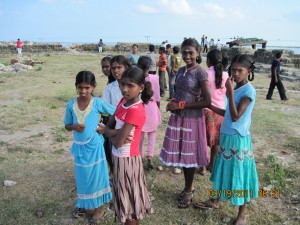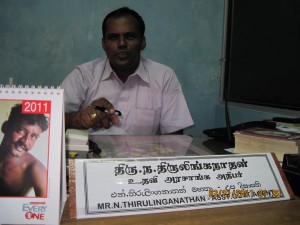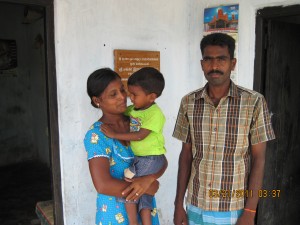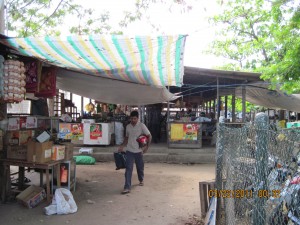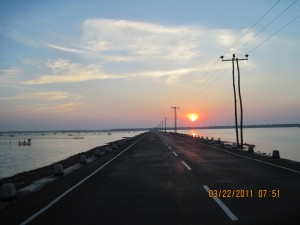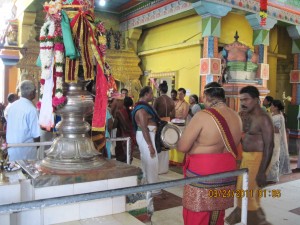The Case of Sri Lanka
Refugees worldwide
Not since the partition of India in 1947 has the world seen refugee problems of the magnitude that we see today. Wars, terrorism, economic deprivation and unprecedented natural calamities have combined to make this the major humanitarian problem of our present time.
The largest numbers today are from the Iraq war. According to the UN High Commission for Refugees report of January 2009, there were 1,955,000 Iraqi refugees in the neighbouring countries of Jordan, Syria, Lebanon, Egypt, Turkey, Iran and the Gulf States[1]. This is apart from the over two million Iraqis displaced within their own country, categorised as Internally Displaced Persons (IDPs). The massive earthquake in Haiti on January 12, 2010, left 300,000 dead and over a million internally displaced persons. Even with the high profile President Clinton as rehabilitation fund manager, over 80% of the displaced are still living in squalid camps with poor sanitation and no access to potable water. In 2005 Hurricane Katrina devastated large parts of New Orleans and the central Gulf States of the USA due to poorly constructed levees protecting the land. It killed 1,836 and permanently displaced a million people who have sought refuge in other parts of the country. After nearly 6 years, only half the population of New Orleans were able to return to the city.
The latest unfolding story is in Libya where the European Union has just formulated new regulations to prevent the entry of tens of thousands now fleeing to escape the fighting in a conflict to which they are a party.
International aid by rich donor nations for catastrophic refugee problems receives high media publicity. But eventually, barely 30% of the promised aid is delivered, corruption and mismanagement eats even a part of this, and eventually attention is focussed on a new problem elsewhere and the victims are forgotten.
The earthquake in Wenchuan County, Sichuan Province, China, which killed 80,000 local residents in 2008 is an exception[2]. Reconstruction work to build new cities, schools and factories are now 91% complete. The Chinese have a reputation for successfully completing massive reconstruction projects at great speed, with their own resources.
Sri Lankan problem
The international community (the international community refers to the Western elite nations, just as when we say London society we do not mean the city population but its small social elite), international media, UN Human Rights Commission and Western human rights organisations have shown extraordinary concern about the refugee problems in the North and East of Sri Lanka since the defeat of the LTTE terrorist military machine on 19 May 2009 after a 35 year insurrection marked by terrorist attacks on schools, villages, government offices, infrastructure and personalities that left over 100,000 dead.
Hence we went to Sri Lanka to visit Jaffna and Trincomalee districts, two of the main centres where people were uprooted by the final military conflict between the LTTE and the Sri Lanka security forces in 2009, to ascertain the situation on the ground for ourselves.
Trincomalee is normal and is prospering. There are no evidences of war damage remaining, either within the huge Trincomalee Fort or outside. We had a long conversation with a Muslim trader from whom I bought Indian sarongs. He was of the view that Trincomalee was one of the most prosperous markets in the country. He had clothing stores in Badulla and Maharagama but he said his shop in Trincomalee was outperforming the others.
First impressions
The first impression of a visitor who has visited Sri Lanka before is that it is safe to travel in the country. After more than three decades, the ever present danger of a terrorist bomb in public places has been erased. In the North and East, where the LTTE restricted travel and enforced taxes on visitors and commercial goods, movement is free. The small towns are prospering again with shops full of local and imported goods and small restaurants. Near some Hindu temples which are usually crowded with worshippers, modern ice cream parlours are a big attraction.
For three decades many parts of the north and east had been under the iron rule of the reclusive LTTE leader, Prabhakaran, who was referred to as the Sun God. It can be assumed that almost the entire population of these regions, where not the slightest opposition was tolerated, would have been associated with this organisation in some form as there was little choice within this brutal dictatorship. But in our conversations with traders and local villagers, we could not find one person who would now admit to having any association with the LTTE.
The refugee situation in the North and East of Sri Lanka is unique and we found it involved three broad categories of former residents:
- the affluent Jaffna middle class
- the Muslim (Moor) residents of Jaffna numbering 100,000 persons and the Sinhala resident numbering about 27,000.
- the lower income Tamil farmers, fisherman, craftsmen and traders.
The Jaffna middle class
The Jaffna middle class was among the most affluent in the country, having been specially privileged from colonial times. They had homes in Jaffna but lived mostly in the south where business and professional interests gave more opportunity for making money and gaining influence. The terrorist movement created divided loyalties for them when it became so powerful militarily as to control large tracts of the North and East, even in areas under government control. The 1983 communal riots which affected middle class Tamils also had a negative impact on their perception of the Sri Lanka government’s ability to protect them from unruly mobs of criminal elements. Many of these families migrated abroad but many others continued to live in the south and abandoned their Jaffna homes to the LTTE. Others, whose main interests were in the north and east of the country, paid the LTTE large sums of money (the tax for leaving territory) and left for developed nations in the West, notably, Canada (with its liberal immigration policy), UK, France, Switzerland, Norway and USA. Over three decades, the Tamil diaspora in the West has risen to a million. They continue to remain a powerful political force for the LTTE which is now extinct in Sri Lanka.
During our visit to Jaffna, we saw thousands of large abandoned bungalows belonging to this affluent class lying in ruins. During the prolonged war, these had been the scene of hand to hand fighting between the LTTE and government forces and the houses had been a cover for fighters. We met a dozen of these expatriate Tamils who had come from Europe and North America to reclaim their property rights with old title deeds. Local officials assured us that their properties would be restored, even though some of these had been taken over by their poor neighbours. These people were primarily interested in establishing their claim to the property and they had no intention of repairing their damaged houses till the areas were cleared of all land mines and the local infrastructure was fully built. It is in the nature of things that the rich will always survive calamities.
Muslim and Sinhala refugees
These people were among the most deprived and harassed but the international media and the HR organisations that champion the cause of the Tamils have chosen to ignore them. Unlike the Tamil groups that have powerful connections to important Western politicians, these people have been forgotten both by the Western media and even by the successive governments of Sri Lanka. During the time when the LTTE controlled land in the north and east, they speedily and savagely ethnically cleansed their territory of non-Tamils. The Sinhala resident population and university students were systematically driven out between 1971 and 1981. In October 1990 the 100,000 Muslim residents were given 24 hours to leave permanently and their properties were seized and given to resident Tamils. Those who failed to leave were murdered. The resettlement of these people is still in limbo. They are living still in the south of the country. This tragedy has still not been addressed.
Low income Tamils
This group has suffered because of the cruelty and inhumanity of the LTTE and prolonged government neglect of the north. G.G. Ponnambalam, the Tamil political leader who sabotaged Prime Minister D.S. Senanayake’s (first Prime Minister of independent Sri Lanka) efforts to create a Sri Lanka identity by insisting that the Tamils were Dravidians and a separate nation, was yet clever enough to join the government and take the key position of Minister of Industries. He used this position to establish major government industries in the North and East: the Cement Corporation, Paranthan Chemicals Corporation and the Valachennai Paper Corporation. Since Northern Tamil politicians, unlike the Indian Tamils of the Central provinces, refused thereafter to join successive governments and became a permanent opposition, they consequently lost out in public funding for major development projects. While the rest of the country developed, the North in particular was left out as their elected representatives sought only to fight the government, first for federated state and then for a separate Tamil state. The result was that development by-passed Jaffna.
The cruelty of the LTTE towards its own people after gaining control of Jaffna has been amply documented. They were not interested in economic development. The billions of rupees allocated by the government as food aid were taken by them and food was sold at high profits. Public servants were paid by the government but had to do the bidding of the LTTE. Taxes were levied on every conceivable activity. The youth and children were conscripted and trained for warfare or as suicide bombers.
In the last stage of the so-called Eelam War IV in 2009, the retreating LTTE military forcibly took along the local population to be used either as fighters or labourers to serve their military and build bunkers and massive defensive earthworks. How many died of ill-treatment by the LTTE and how many were war casualties during the LTTE’s military retreat is unrecorded but many of them are now classified as “missing persons” and are one aspect of the LTTE and Western political campaign against the government which is now held accountable for these missing people. These 300,000 hostages are those who escaped to the government side as the LTTE fought its last unsuccessful battles on the eastern coastline. They became refugees till they were able to resettle in their former villages.
Post-War reconstruction in Jaffna
After two years in refugee camps, 85% of the poor Tamils displaced by the war have been re-settled. The major bar to reconstruction is the presence of hundreds of thousands of landmines laid randomly by the retreating LTTE army towards the close of the war. De-mining teams can usually access maps of mined areas when mines are laid by regular armies. The departing LTTE scattered mines at random making de-mining extremely difficult.
In Jaffna, the two major industrial complexes, the Kankasanthurai Cement factory and the Paranthan Chemicals Corporation have been destroyed. The Cement factory closed when the LTTE murdered the Sinhalese managers at the site. The prospects for future industrial development to absorb the non-farm population and provide managerial jobs for locally qualified personnel (the Jaffna University functioned throughout the war as part of the Sri Lanka university system) depends on government’s ability to quickly develop the infrastructure which is still poor. The government has offered capital and fiscal concessions Colombo businessmen to establish factories in Jaffna. But one such businessman who had done a preliminary of survey of Jaffna told us that felt he should wait till the roads, railways and electricity services improved.
However, the Jaffna farmers, among the best in the country, have shown their resilience by expanding agricultural production. Agricultural loans in the Jaffna District were the highest for any district in the country in 2010 and the carefully tended farmlands are now among the best in the country.
The fishing industry has revived with the restrictions on deep-sea fishing removed after the end of the war. But it has still to catch up with the industry elsewhere in the country where large locally-made trawlers have now replaced the old catamarans and small craft with limited capacity. The industry needs more investment. But the Jaffna fishermen are also resourceful. Travelling the five mile long causeway across the sea to the island of Karaitivu, we saw enclosed fish and prawn farms on either side as far as the eye could see.
Developments in Vadamarachchi East
We visited the Assistant Government Agent (AGA, chief local area government officer) of Vadamarachchi East, Mr. N. Thirulinganathan, to discuss resettlement issues in his area. His domain covered 18 Grama Niladari divisions (village clusters). He said that people in 11 divisions had been fully resettled while 7 divisions are awaiting re-settlement. He said that the delay was due to landmines which are still being cleared in these divisions. Except for a small area in the northern part, most of the other lands were sandy and unsuitable for cultivation and fishing was the major occupation. He said that larger loans to fishermen were required to enable them to obtain bigger boats and better fishing nets. In the meanwhile, one of the few major industries in the area was mining sand from the numerous sand dunes to supply the local construction industry. The AGA had the authority to issue sand mining permits which were used by small operators as well as a giant operator, Maheshwari Foundation, which employed hundreds of tractors.
Role of the Sri Lanka Army
The Sri Lanka Army still plays a key role in Jaffna as security is still an issue after the war which lasted three decades. Overseas Tamil political groups in the USA and UK have formed Tamil Eelam Governments in Exile and threaten to resume the LTTE cause in Sri Lanka. While some High Security Zones under Army control have been handed back to the civilian authorities, others remain. Regular army patrols were stopped about six months ago but after a spate of robberies, murders and other activities by criminal elements the army resumed its patrols at the request of local residents.
Unlike the common scenario where military presence is used to intimidate the local population, the army in Jaffna is now on a high public relations mode. All outside vehicles entering Jaffna through Elephant Pass are checked by security personnel and given written and verbal instructions to be polite and civil to the local population and to drive with extreme courtesy. I have never come across such an effort in any other conflict zones of the world which I have visited as a business traveller.
In the Amban Grama Niladari Division in Vadamarrachchi East, we found that the army personnel were building 500 houses for local residents with money contributed by soldiers. Presently, 150 houses are complete and occupied. We visited several households here and talked to the occupants and they all had a good word for the army. This new relationship bodes well for the future.
Adequate good quality housing is still a problem in the settlement areas. An Indian government aid project was to build 50,000 houses and construct the destroyed railway lines from Vavuniya to Jaffna[3]. The work still remains to be done.
[1] Quoted from the study by Drs. Philip Marfleet and Dawn Chatty of the Oxford University’s Refugee Study Centre accessible at http://www.rsc.ox.ac.uk/publications/policy-briefings/RSCPB4-Iraqsrefugees.pdf
[2] http://news.xinhuanet.com/english2010/special/2011-05/10/c_13864797.htm
[3] The LTTE had dismantled the railway and used the steel lines to reinforce their military bunkers.
Kenneth Abeywickrama
13 May 2011
I too visited Jaffna, Kilinochchi and Mulativu last week. Congratulations, You have given a very clear and true picture of situation in the North and East without bias. Hope this article will be read by non sri lankans who are often bombarded with LTTE influenced articles for which our own diplomats are responsible. Plight of the refugees are indeed tragic and unfortunate but solutions are not easy as you have clearly revealed the situations in other countries. You have exposed the hipocracy of the western countries. How nice would it be to have a few more sri lankans of you calibre who could counter balance the propaganda of the tamil diaspora.
Amare

